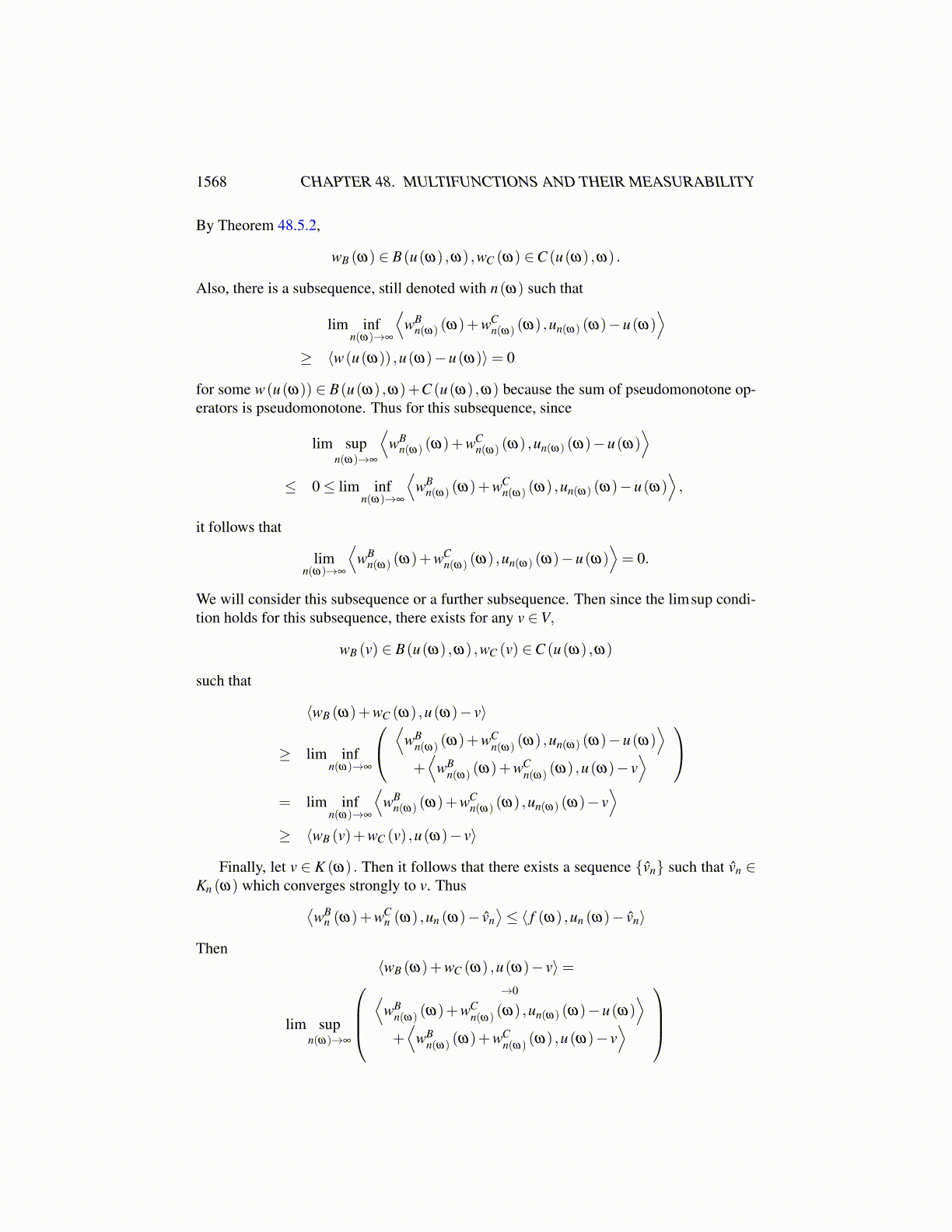
1568 CHAPTER 48. MULTIFUNCTIONS AND THEIR MEASURABILITY
3. Limit conditions
If un ⇀ u and lim supn→∞
⟨zn,un−u⟩ ≤ 0, zn ∈ A(un,ω)
then for given v, there exists z(v) ∈ A(u,ω) such that
lim infk→∞
⟨zn,un− v⟩ ≥ ⟨z(v) ,u− v⟩
Thus, for fixed ω,A(·,ω) is a set valued bounded pseudomonotone operator. Recall thatthe sum of two of these is also a set valued bounded pseudomonotone operator.
By Theorem 48.3.1 if ω → u(ω) is measurable, then A(u(ω) ,ω) has a measurableselection. Also, the limit condition implies that A(·,ω) is upper semicontinuous from thestrong to the weak topology. The overall approach to the following theorem is well known.The new ingredients are Lemma 48.2.2 and Theorem 48.3.3 which are what allows us toobtain measurable solutions. First is a standard result on the sum of two pseudomonotonebounded operators. See Theorem 25.5.1 on Page 855.
Theorem 48.5.2 Say A,B are set valued bounded pseudomonotone operators. Then theirsum is also a set valued bounded pseudomonotone operator. Also, if un→ u weakly, zn→ zweakly, zn ∈ A(un) , and wn→ w weakly with wn ∈ B(un) , then if
lim supn→∞
⟨zn +wn,un−u⟩ ≤ 0,
it follows that
lim infn→∞⟨zn +wn,un− v⟩ ≥ ⟨z(v)+w(v) ,u− v⟩ , z(v) ∈ A(u) ,w(v) ∈ B(u) ,
and z ∈ A(u) ,w ∈ B(u).
Theorem 48.5.3 Let V be a reflexive separable Banach space. Let ω → K (ω) be a mea-surable multifunction, K (ω) convex, closed, and bounded. Also for A = B,C let A(·, ·)satisfy 1 - 3. Let ω→ f (ω) be measurable with values in V ′. Then there exists measurableω → u(ω) ∈ K (ω) and ω → wB (ω) , ω → wC (ω) with wB (ω) ∈ B(u(ω) ,ω) ,wC (ω) ∈C (u(ω) ,ω) such that
⟨ f (ω)− (wB (ω)+wC (ω)) ,z−u(ω)⟩ ≤ 0
for all z ∈ K (ω). If it is only known that K (ω) is closed and convex, the same conclusioncan be obtained if it is also known that for some z(ω)∈K (ω) , B(·,ω)+C (·,ω) is coercivemeaning
lim∥v∥→∞
inf{⟨z∗,v− z⟩∥v∥
: z∗ ∈ B(v,ω)+C (v,ω)
}= ∞.
Proof: Let Vn =Vn (ω) denote an increasing sequence of finite dimensional subspaceswhose union is dense in V. Let Vn (ω) contain the first n vectors of {dk (ω)}∞
k=1 where theclosure of this sequence equals K (ω) for each ω , each function being measurable. Let
Vn (ω) = span(v1, · · · ,vn,d1 (ω) , · · · ,dn (ω)) .